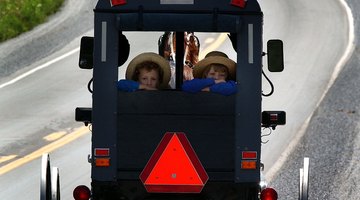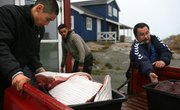The Amish are a loosely connected network of conservative Anabaptist communities that originated in Switzerland. They broke from the Mennonites in Switzerland between 1693 and 1697. They are followers of Jakob Ammann, who spearheaded the schism because he favored harsher excommunication practices and more conservative modes of dress. The Mennonites and Amish still share basic Anabaptist values, like opposition to both war and infant baptism. Amish communities have disappeared from Europe, and now exist solely in North America. They are easy to identify from their horse-drawn wagons and 17th century clothing. Amish women must wear cape dresses and head coverings in public. There is some division between various Amish groups, largely centered around disputes about evangelism and cultural assimilation.
Old Order Amish
The Old Order Amish constitute the largest group of rural Amish settlements descended from the Amish Mennonites. They are known for their strict rules involving dress. Old Order Amish communities often prohibit the use of buttons and zippers, for example. They also wear dark colors, mostly black. The communities regulate hair length -- men must grow beards an acceptable length, and women are not allowed to get haircuts. Old Order Amish people also oppose church buildings, preferring to meet in individual homes. This reflects their wariness of organized religion in general; they think of their house meetings as more organic and unregulated. They also eschew modern technologies like cars, electricity and tractors.
New Order Amish
The New Order Amish, sometimes called the Amish Brotherhood or the New Amish, are Amish settlements that grew out of the Old Order Amish communities in the mid-20th century. They are similar to the Old Order Amish, with slightly relaxed rules governing dress and technology. Colorful clothing is permitted, and men are allowed to trim beards. The communities allow some modern technologies, like telephones, tractors and even airplane travel. They are also more evangelical than the Old Order Amish, promoting born-again experiences among young people and sending missionaries into non-Amish communities. They are stricter than the Old Order Amish when it comes some practices, like the prohibition of alcohol and tobacco.
Beachy Amish
The Beachy Amish broke from the Old Order Amish at the turn of the 20th century, largely because of disputes over evangelicalism in the United States. They admired the revivalism of many churches in the country, like the Baptists and Methodists -- and were convinced by their messages of individual salvation. The Beachy Amish began holding their own tent revivals, a practice firmly opposed by the larger Old Order Amish settlements. They group is more relaxed when it comes to technology and dress than other Amish communities, on the grounds that they do not find biblical references that prohibit the use of buttons and some other basic innovations. They also allow cars and home electricity -- and send missionaries to proselytize throughout the world.
Swartzenruber Amish
The Swartzenruber Amish are a subset of the Old Order Amish known for being even stricter than most Old Order Amish people -- and for having lower standards of living. They are quicker to excommunicate and even more isolated from any non-Amish people. Their standards of dress are harsher, and members may not even ride in cars owned by non-Amish people, except in some emergencies. Their parochial schools are less rigorous than the usual eighth grade education provided in Old Order Amish schoolhouses. The Swartzenruber Amish see themselves as the truest heirs to the Anabaptist Amish tradition.
Related Articles
References
Writer Bio
Christina Lee began writing in 2004. Her co-authored essay is included in the edited volume, "Discipline and Punishment in Global Affairs." Lee holds a Bachelor of Arts in English and politics from the University of North Carolina at Chapel Hill, a Master of Arts in global affairs from American University and a Master of Arts in philosophy from Penn State University.











